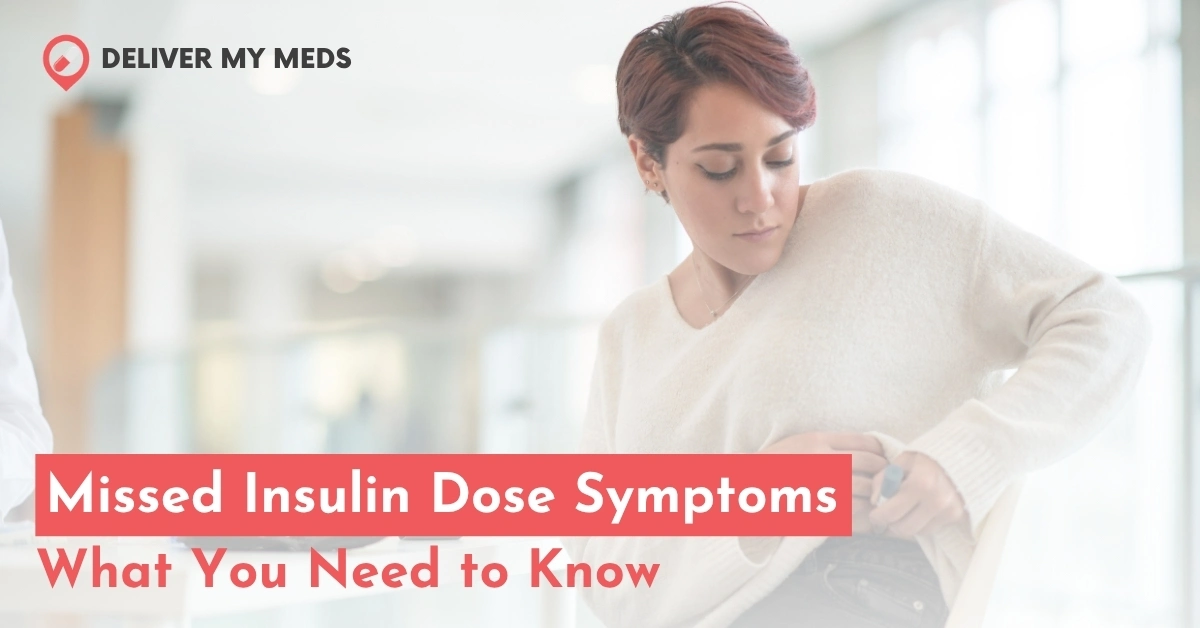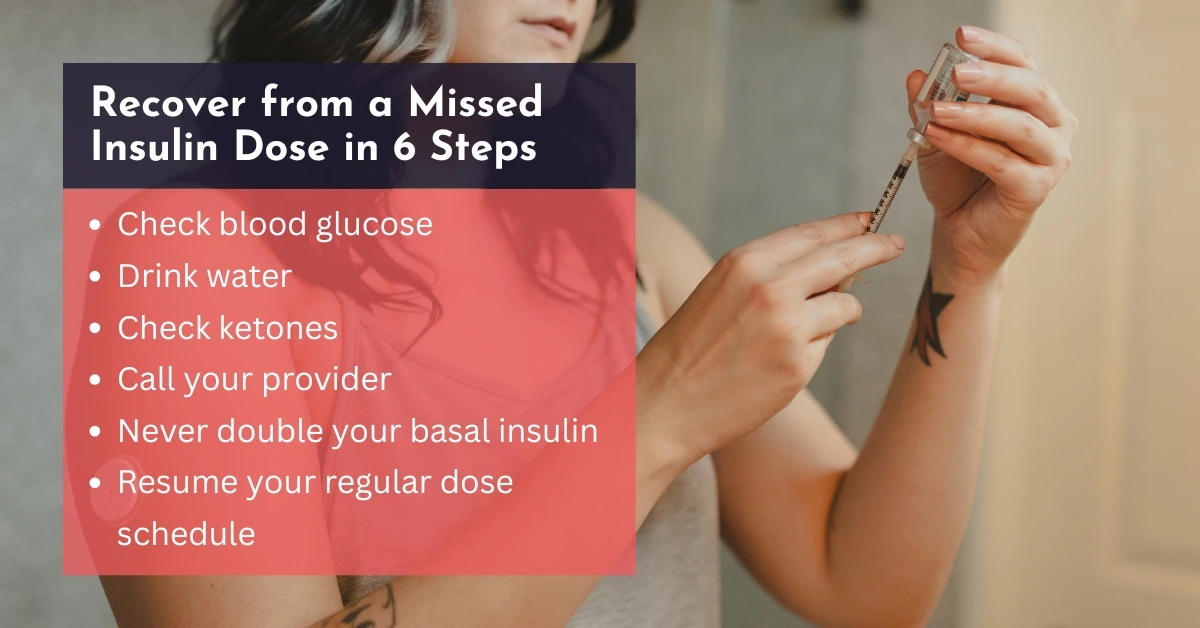
Missed Insulin Dose Symptoms: What You Need to Know
Forgetting to take insulin is a frequent occurrence when starting bolus or basal injection in people, but may cause blood sugar fluctuations. The next step is to prevent symptoms of missed insulin doses, including tiredness, excessive thirst, blurry vision, and, in severe cases, diabetic ketoacidosis (DKA) or hyperosmolar hyperglycemic state (HHS).
Every insulin dose matters, both in the conditions of Type 1 and Type 2 diabetes management. It helps to avoid complications and control the A1C level. Do you forget to take insulin before a meal, forget your usual Lantus injection, or forget your night-time basal dose? Each can affect blood glucose differently and requires specific explanation.
This guide provides information about what to do in case the dose is missed, what the urgent symptoms are, how long the insulin can be postponed and how to recover as well as commence. We built this guide from real patient calls and forum questions like ‘Is it dangerous to skip insulin just once? So, the advice is based on real-world diabetes experiences
Type 1 vs. Type 2: What Happens If You Miss Insulin?
| Diabetes Type | Missed Dose Effect |
| Type 1 | DKA within 6–24 hours; emergency risk |
| Type 2 | Gradual organ damage, high glucose, HHS risk |
CGMs and an automated delivery device from DMM offer tailored support for both populations.
Missed Insulin Dose Symptoms: Warning Signs
Right after missing insulin, you may notice:
- Excessive thirst
- Frequent urination
- Blurry vision
- Fatigue or mood swings
- Dry mouth or headache
In Type 1 diabetes, skipping insulin can lead to DKA, presenting with:
- Nausea, vomiting
- Fruity breath
- Deep, fast breathing
- Abdominal pain
In Type 2 diabetes, symptoms develop more gradually but can still lead to long-term damage if insulin is consistently missed. Always test your blood glucose after a missed dose.
Type 2 Diabetes and Missed Insulin Up to 3 Days
In Type 2 diabetes, missing one long-acting insulin dose might not show symptoms right away, but skipping for 1-3 days can lead to:
- Persistent hyperglycemia
- Increased insulin resistance
- Kidney damage
- Neuropathy
- Retinopathy
- Cardiovascular risks
Within 24 hours of high glucose, the body is dehydrated, and the efficiency of insulin also declines. FreeStyle Libre 3 is a CGM device that can monitor an inclined trend in the background.
In case the level of glucose in blood reaches more than 300 mg/dL and such symptoms as vomiting, confusion, or shallow breathing appear, make calls to emergency. Use DMM’s monthly insulin subscriptions of Libre 3 Plus to avoid accidental lapses.
Forgot to Take Insulin Before Meal?
Forgetting mealtime insulin, especially after a high-carb meal, may trigger a blood sugar spike within 1-2 hours. Symptoms include:
- Fatigue
- Dry mouth
- Blurry vision
- Headache
- Frequent urination
If it’s been under two hours, your provider may recommend a correction dose, but never guess. Avoid insulin stacking. Use a CGM like Dexcom G7 Starter Kit or FreeStyle Libre 3 Plus to monitor trends and act accordingly.
If you’re out of supplies, DMM’s same-day delivery can quickly restore access and prevent further missed doses.
Forgot Lantus Dose? Catch-Up Strategies & Dangers
- Lantus (insulin glargine) is a long-acting insulin. Missing a Lantus dose may elevate fasting glucose levels significantly.
- If it’s been a few hours, some providers allow taking the dose, but always check glucose and ketones first.
- Do not double the next dose to compensate. Doing so increases the risk of hypoglycemia.
- Call your diabetes care team and resume your regular timing the next day. Deliver My Meds offers recurring subscriptions to keep your insulin on schedule without the risk of running out.
Life-Threatening Symptoms: Severe Hyperglycemia
As per MayoClinic, DKA (Diabetic Ketoacidosis) occurs when there’s severe insulin deficiency, primarily in Type 1 diabetes. Warning signs:
- Nausea or vomiting
- Fruity breath smell
- Deep, rapid breathing
- Abdominal pain
- Confusion or extreme fatigue
For Type 2 diabetes, prolonged high glucose without ketones may cause Hyperosmolar Hyperglycemic State (HHS):
- Severe dehydration
- Altered mental status
- Possible coma
Both require emergency care. Dexcom G6 and Libre 3 systems provide real-time alerts to prevent reaching this stage.
Missed Insulin Overnight
Overnight missed insulin (usually basal) may lead to:
- Very high fasting glucose
- Nausea
- Headache
- Morning fatigue
Wondering, “What if I forgot to take evening insulin?”:
- Check glucose first thing
- Avoid doubling your morning dose
- Hydrate and contact your provider
Set a bedtime alert or pair your regimen with DMM’s delivery tracking and refill tools to avoid future night-time misses.
Recover from a Missed Insulin Dose in 6 Steps
Steps to follow:
- Check blood glucose
- Drink water
- Check ketones
- Call your provider
- Never double your basal insulin
- Resume your regular dose schedule
Deliver My Meds supports recovery with same-day delivery, refill alerts, and CGM-compatible solutions. Patients often call or message us saying: “I forgot my Lantus last night, what do I do?” or “My pump site failed and I didn’t notice until morning.” These aren’t hypothetical cases; they’re real, daily concerns that we help address by getting CGMs, sensors, and insulin to patients quickly. Our goal is to reduce missed-dose stress by ensuring you never go without the tools you rely on.
Table: Symptoms by Missed Dose Duration
| Time Missed | Symptoms |
| 1 Dose | Fatigue, thirst, elevated blood sugar |
| Overnight | High fasting glucose, nausea, possible ketones |
| 1–2 Days | Blurred vision, dehydration, nausea |
| 3+ Days | DKA (Type 1), HHS (Type 2), risk of coma |
Smart Insulin Alerts and Tracking Devices That Work
Technology can prevent dangerous lapses. Use:
- Dexcom G6/G7: Sends alerts when blood sugar rises too fast
- Libre 2/3 Apps: Tracks trends + sends low/high notifications
- Phone alarms: iOS/Android calendar alerts
- Fridge labels or logbooks: Visual cues
Pair them with DMM’s refill system for peace of mind.
Table: Tools to Improve Insulin Adherence
| Tool Type | Examples / Description |
| CGM Alerts | Dexcom G6/G7, Libre 2/3 – Track trends + detect insulin-related highs/lows |
| Phone-Based Reminders | iPhone/Android alarms, recurring calendar events |
| Visual Aids | Sticky notes, labeled storage, and insulin logbooks |
| Delivery Support | DMM: Monthly refills, Auto-ship, Emergency Delivery |
Best Habits to Remember Your Insulin
Proven strategies:
- Link insulin uses with daily habits (e.g., brushing teeth)
- Use mirrors or fridge reminders
- Keep insulin visible in your routine space
- Involve caregivers if needed
Consistency beats crisis.
Prevent Missed Doses in the Future
- Set triple reminders: Alarm → Confirm → Log
- Use smartwatches or CGMs to track dose time
- Store insulin in a portable case for travel
- Ask your provider about simplified regimens
- Use DMM’s automated delivery to eliminate refill gaps
Every tool matter when it comes to long-term glucose control.
Conclusion
Missed insulin dose symptoms, whether mild or life-threatening, should never be ignored. From DKA in Type 1 diabetes to HHS in Type 2, the consequences of skipping insulin range from subtle to catastrophic. Early detection, smart tech, and dependable delivery support are key to prevention. Deliver My Meds ensures you never miss a dose again with auto-refill, fast delivery, and support for the tools that keep your diabetes managed, day and night.




